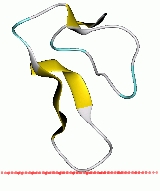
Agouti-related peptide
Overview
Agouti-related protein also called Agouti-related peptide (AgRP) is a neuropeptide
produced in the brain
by the AgRP/NPY neuron. It is only synthesised in NPY containing cell bodies located in the ventromedial part of the arcuate nucleus
in the hypothalamus. AgRP is co-expressed with Neuropeptide Y
and works by increasing appetite
and decreasing metabolism
and energy expenditure. It is one of the most potent and long-lasting of appetite stimulators.
Neuropeptide
Neuropeptides are small protein-like molecules used by neurons to communicate with each other. They are neuronal signaling molecules, influence the activity of the brain in specific ways and are thus involved in particular brain functions, like analgesia, reward, food intake, learning and...
produced in the brain
Brain
The brain is the center of the nervous system in all vertebrate and most invertebrate animals—only a few primitive invertebrates such as sponges, jellyfish, sea squirts and starfishes do not have one. It is located in the head, usually close to primary sensory apparatus such as vision, hearing,...
by the AgRP/NPY neuron. It is only synthesised in NPY containing cell bodies located in the ventromedial part of the arcuate nucleus
Arcuate nucleus
The arcuate nucleus is an aggregation of neurons in the mediobasal hypothalamus, adjacent to the third ventricle and the median eminence...
in the hypothalamus. AgRP is co-expressed with Neuropeptide Y
Neuropeptide Y
Neuropeptide Y is a 36-amino acid peptide neurotransmitter found in the brain and autonomic nervous system."NPY has been associated with a number of physiologic processes in the brain, including the regulation of energy balance, memory and learning, and epilepsy." The main effect is increased food...
and works by increasing appetite
Appetite
The appetite is the desire to eat food, felt as hunger. Appetite exists in all higher life-forms, and serves to regulate adequate energy intake to maintain metabolic needs. It is regulated by a close interplay between the digestive tract, adipose tissue and the brain. Decreased desire to eat is...
and decreasing metabolism
Metabolism
Metabolism is the set of chemical reactions that happen in the cells of living organisms to sustain life. These processes allow organisms to grow and reproduce, maintain their structures, and respond to their environments. Metabolism is usually divided into two categories...
and energy expenditure. It is one of the most potent and long-lasting of appetite stimulators.
Discussions

